
Now that you’ve performed the experiment and see some colonies nurtured in the agar of your petri dishes, you’re probably wondering: what’s in there? What am I actually looking at? Here are some broad guidelines for figuring out what you’ve grown in each petri dish (we’ll have some specific ideas in a bit):
- Bacteria: these colonies are mostly circular in shape, and they’ll probably be white, cream, yellow, or occasionally red.
- Yeasts: look a lot like the bacteria colonies. As with bacteria, can be different shapes, often colored white or cream. They may have a glossy surface.
- Molds and fungi: much more distinctive; they’re often grey, or whitish grey, and fuzzy, especially at the edges. The center and outer edges may also be different colors.
Figuring out the specific species you’ve got growing can be a little tougher, though. There are over 3,500 different genera of bacteria, with more than 20,700 specifically known and named species. And that’s just the tip of the iceberg: scientists think there are probably over 200,000 total species! To identify them, microbiologists consult Bergey's Manual of Determinative Bacteriology, a 750 page book that lists the colony characteristics, then cross-reference that with the much longer (!) 4-volume Bergey's Manual of Systematic Bacteriology. For preliminary identification, scientists rely on four characteristics: the color (pretty obvious), the form (shape of the colony), elevation (what it would look like in cross-section), and the margin (the shape of the colony’s edges). Here’s a general guide:

While it’s possible to identify the type of growth just by looking at the colonies, determining the specific species usually requires more specialized equipment: particularly a microscope for identifying the shape of an individual microorganism in the colony. And since there are over 150 species of bacteria on your hands alone, we unfortunately can’t give you a rundown of everything that might be growing on your petri dishes. But a few good possibilities of what you might be looking at, and their characteristics, are right here:
- Bacillus subtilis - color is dull white, margin is undulate, form is irregular
- Escherichia coli - color is off-white or beige, texture is shiny, and margin is entire. The famous E. Coli sometimes has concentric growth rings, but you need a microscope to see them.
- Micrococcus luteus - color is bright yellow, margin is entire, colonies have a smooth surface and a convex (dome-like) surface
- Seratia - this is a common genus with a number of species, color is red and margins are entire.
So, how many bacteria are in each colony you’re growing? Of course that depends on the species of bacteria present in the colony (they come in many different sizes) and how large the colony dot on your petri dish is. In general, common bacteria are often around 2 microns wide and 10 microns long; so in a round area about 1 centimeter in diameter, you’d find (very) roughly 3,920,000 individual bacteria.
And that’s nothing! A teaspoon of soil has around 1,000,000,000 (a billion) bacteria, and there are about 1,000,000,000,000 (1 trillion) living in your digestive system! Current estimates suggest that there are 5,000,000,000,000,000,000,000,000,000,000 (5 million trillion trillion) bacteria living in the Earth’s ecosystems (including) us; that’s 2,500,000,000,000,000,000,000 times the number of stars in the entire Milky Way!
As with any science experiment, please remember to stay safe: wash your hands after handling any of the dishes, keep food and drinks away from them, and dispose of everything in a ziploc bag when your experiment is done.
We hope you enjoy this incredible opportunity to transform the microscopic into the macroscopic, and explore the wonders that are all around (and inside of) you!

P.S. You might be wondering about the agar in your kit, which is used as the medium for growing the bacteria: agar is a gelatinous compound derived from red algae seaweed! It was first discovered in Japan in 1658 and is now used around the world for food (often sugary treats). Agar began to be used as a basis for lab-grown bacteria in the early 1980s. Scientists use different types of agar to grow bacteria, with some better at hosting specific species than others: for example, chocolate agar (named for its color, which comes from sheep blood used to make it) is good for Haemophilus and Neisseria, and tissue grade agar is used for growing plants. We’ve given you nutrient agar, which is a great medium for growing a broad range of common bacteria and fungi.

